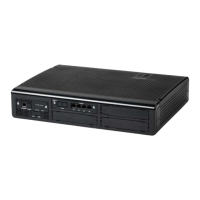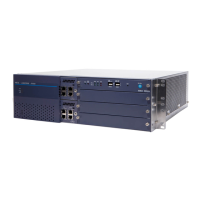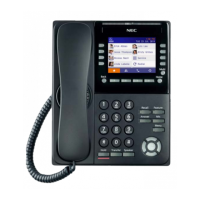CHAPTER 5 FEATURE DESCRIPTION
UNIVERGE NEAX 2000 IPS General Description Page 137
Issue 5
• CCIS Networking via IP (Non Peer-to-Peer Connections Basis)
When the distant
systems are 2000 IVS2, the systems are connected with IP trunks [including Voice
Compression Trunks (VCT)], via Time Division Switch (TDSW). Voice signals of IP
Enabled Dterm terminals are transmitted via IP-PADs, while those of legacy terminals are
directly connected to the IP trunks. Call control signals between the systems are also
transmitted over the IP trunks. Voice compression of G.729a (8 kbps) and G.723.1 (5.3
kbps / 6.3 kbps) can be provided by the IP trunks with VCT cards. This connection is also
applicable when the distant systems are 2400 IPX not supporting peer-to-peer connections.
Centralized Billing - CCIS
This feature is used to collect billing information from each office within the network and to
direct it to the associated center office. Billing information is then forwarded to the central
billing centers via RS232C interfaces.
Centralized Day/Night Mode Change - CCIS
This feature switches the Day/Night mode of a remote office, linked to the main office (2400
IPX) via CCIS, in accordance with the Day/Night mode switching on the Attendant Console at
the main office.
Centralized E911 – CCIS
This feature allows the system to transmit a calling party number to the 911 Emergency systems
over CCIS tandem connection.
Consultation Hold - All Calls - CCIS
This feature permits a station user, within the CCIS network, to hold any incoming or outgoing
public network or Tie Line call while originating a call to another station within the CCIS
network.
Data Line Security - CCIS
This service feature allows the lines which are used for data transmission through CCIS to be
protected from interruptions such as Attendant Camp - On, Busy Verification - CCIS, Executive
Right of Way, and Attendant Override.
Deluxe Traveling Class Mark - CCIS
This feature provides outgoing call restrictions within the CCIS network. The following three
types of restrictions are allowed:
• Deluxe Traveling Class Mark Restriction
• Route Restriction
• Numbering Restriction
Dial Access to Attendant – CCIS
This feature allows a station user to call an Attendant Console by dialing an operator call code
through the CCIS network.
Digital Display - Station - CCIS
This service feature provides a display of the station number on the Attendant Console, during an
Attendant-to-station connection, within the CCIS network.
Digital Display - Trunk - CCIS
This service feature provides the Attendant with a visual indication of incoming and outgoing
trunk calls during an attendant-to-trunk connection within the CCIS network. Trunk Group
number and trunk identification code are displayed.

